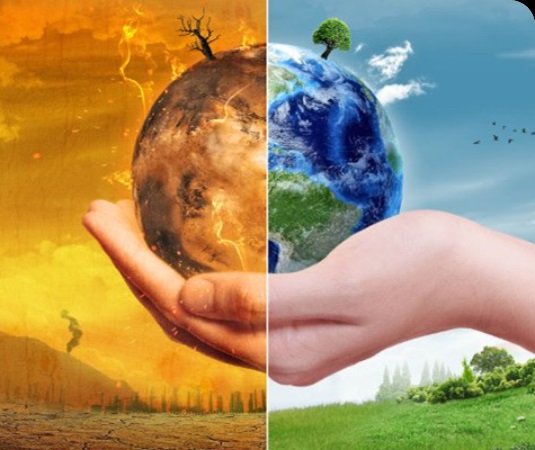
BY KFLEEYESUS ABEBE
Studying and seeing as greenhouse gases level increased, glaciers shrink, ice on rivers and lakes breaking up, scientists have been early to call upon people, institutions and world leaders to act and control or mitigate climate change. However, the world failed to act early due to lack of enough awareness, commitment and others, the effect of climate change came for everyone to see it in naked eyes though.
Climate change has continued distressing the world, causing fatalities and destruction of properties. From Tsunami to hurricane Mathew and winter storm in America, massive earthquake in Haiti, huge and recurrent wildfire in California, Israel and Australia, flood, drought and famine in sub-Saharan Africa, climate change has already shocked the world with their unimaginable havoc on peoples’ livelihoods. Seeing these devastating impacts, scientists have continued to urge people to protect the ecosystem and take actions that halt the rapid change of the environment.
As Global Citizen, close to 14,000 scientists made another round of calls to perform simple actions like reducing carbon emissions, restoring the ecosystem and halting climate change. In their letter, scientists indicated the urgency of reducing the use of fossil fuels such as oil, carbon and natural gas and replacing them with renewable and cleaner sources of energy. The scientists also on the other hand suggest restoring and protecting the ecosystem. They indicated nature-based solutions should be central to any climate change strategy. Forests, mangroves, wetlands and other ecosystems can absorb tremendous amounts of green gas emissions.
The latest report of the intergovernmental panel (IPCC) on climate change signals a “code red” for human kind in terms of widespread extreme weather events. The report shows the near-linear relationship between carbon emissions (cumulative anthropogenic CO2 emissions), as the result of burning fossil fuels and deforestation, and the planetary warming that is driving climate change. As to the report, unless immediate action is undertaken to drastically reduce carbon emissions, the warming will be high and nowhere will be safe. Therefore, the IPCC calls on no new coal fired power stations to be built and countries to phase out existing coal by 2030. All nations are urged to shift fossil fuel subsidies into renewable energy and keep on tacking on achieving net-zero emissions by 2050. The IPCC stresses on the need of making life styles friendly, environmentally sustainable and energy efficient by assisting non carbon intensive travel that reduces demand for transportation fuels. However, according to IPCC, the world can handle this issue better through prioritizing protection of the ecosystem. It says “we might approach the latter “biosphere” with an emphasis on protecting nature and allowing it to achieve its full potential, in which case various problematic issues begin to fall into line.”
It may not be enough given the rapidity of change in global atmosphere but there are countries such as the United Kingdom, Norway, France and New Zealand that have legally committed to reach net zero emissions by 2050. Despite support from developed countries isn’t adequate as the Paris agreement dictated, African countries are also striving to mitigate the effects of climate change by using natural solutions. The United Nations framework convention on climate change (UNFCCC) has been encouraging this initiative by positive incentives for reduction of emissions of greenhouse gases stemming from tropical deforestation and forest degradation as climate change mitigation measures. According to the state of forest carbon finance report, nearly $ 3 billion has flown into countries worldwide.
Ethiopia comes in the front picture among nations that are determined to curb carbon emission by implementing various mechanisms. It was decisive and among signatories of the Paris agreement committing itself to cut carbon emissions by 64% by 2030. Ethiopia has adopted its mitigation policy in 2011 as Climate Resilient Green Economy strategy aiming to keep greenhouse gas emissions low and build climate resilience, while achieving middle-income status by 2025. The strategy is based on four pillars; reducing agricultural emissions, protecting and expanding forests, expanding renewable energy and adopting energy efficient technologies. Though the strategy is currently under review, it has produced significant results.
Climate Action Tracker rates Ethiopia’s Paris Agreement target as “2”c compatible and one of the few countries to earn this rating. The CAT also says ‘This rating indicates that Ethiopia’s climate plans are within the range of what is considered to be a fair share global effort,” As a report from COMESA, its key successes are in afforestation and land rehabilitation, generation and distribution of electricity from clean and renewable sources and investment in improved transportation systems.
In May 2019, Ethiopia launched its National Green Development Program led by Prime Minister Abiy Ahmed. The plan includes a green legacy campaign that mobilizes people across the nations to plant seedlings. As Prime Minister Abiy Ahmed puts it, this initiative is meant to “preventing flooding, food insecurity, environment related conflicts and other adverse effects.” In 2019 alone, Ethiopia managed to plant four billion seedlings. In the second green legacy, as carried out in 2020, 5 billion seedlings were planted and broke a record that was held by India. This initiative is anticipated to sustain for years to come and increase Ethiopia’s forest coverage.
Another significant action taken by Ethiopia is its tendency to renewable energy. Ethiopia has begun to fill the Grand Ethiopian Renaissance Dam which will be the largest hydro-electric plant on the continent when it is fully operational. The dam has the capacity of generating. It is also part of the World Bank’s Scaling Solar program and in April 2019 the Ethiopian Ministry of finance the second round of tenders for up to 750 MW. The first round, for two projects totaling 250 MW, was awarded to Saudi energy development AWCA power in September 2019. Taking freight and passenger transport contribution to carbon emission into account, the government plans to increase fuel efficiency standards and promote the uptake of hybrid and electric vehicles. It also constructed a renewable energy powered electric rail network and improved public transportation in the capital, Addis Ababa. It is increasing the use of biofuels.
This effort has helped the country to withstand various environmental related challenges such as El Nino induced drought. In addition Ethiopia’s struggle against climate change has got global attention thereby it got a boost from the Green Climate Fund. For instance, in 2017 Ethiopia secured 50 million USD to implement similar projects over the course of five years.
Developing nations such as Ethiopia are contributing a lot in mitigating the effects of climate change by building clean, climate resilient futures. If developed nations fulfill their commitment to the Paris agreement and support the efforts of developing countries by finance, technology and capacity building, a lot could be achieved.
Therefore, if other countries follow Ethiopia’s lead, there is still a chance for the world to survive. Otherwise, as IPCC puts it in 2050 the world would be fated to be warm as “hell on Earth.”
THE ETHIOPIAN HERALD AUGUST 20/ 2021




